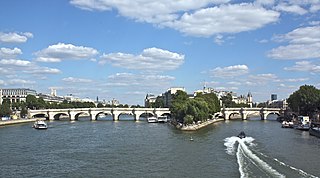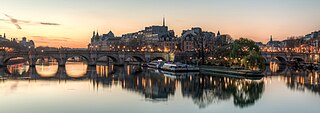
The Pont Neuf is the oldest standing bridge across the river Seine in Paris, France. It stands by the western (downstream) point of the Île de la Cité, the island in the middle of the river that was, between 250 and 225 BC, the birthplace of Paris, then known as Lutetia and, during the medieval period, the heart of the city.

Île de la Cité is an island in the river Seine in the center of Paris. In the 4th century, it was the site of the fortress of the Roman governor. In 508, Clovis I, the first King of the Franks, established his palace on the island. In the 12th century, it became an important religious center, the home of Notre-Dame cathedral, and the royal chapel of Sainte-Chapelle, as well as the city's first hospital, the Hôtel-Dieu. It is also the site of the city's oldest surviving bridge, the Pont Neuf.

Châtelet is a station of the Paris Métro and Île-de-France's RER commuter rail service, located in the centre of medieval Paris, on the border between the 1st and 4th arrondissements. It serves RER A, RER B and RER D, as well as Line 1, Line 4, Line 7, Line 11 and Line 14 of the Paris Métro; it is the southern terminus of Line 11. The station is made up of two parts connected by a long corridor: Lines 7 and 11 under the Place du Châtelet and the Quai de Gesvre, next to the Seine; Lines 1, 4 and 14 towards Rue Saint-Denis and the Rue de Rivoli.

Pont de Sèvres is a station of the Paris Métro on line 9, serving as its western terminus. It is located near the pont de Sèvres, which is a bridge on the Seine connecting to Sèvres.

Claude-Louis Navier was a French mechanical engineer, affiliated with the French government, and a physicist who specialized in continuum mechanics.

The Pont au Change is a bridge over the Seine River in Paris, France. The bridge is located at the border between the first and fourth arrondissements. It connects the Île de la Cité from the Palais de Justice and the Conciergerie, to the Right Bank, at the Place du Châtelet.

The Place du Châtelet is a public square in Paris, on the right bank of the river Seine, on the borderline between the 1st and 4th arrondissements. It lies at the north end of the Pont au Change, a bridge that connects the Île de la Cité, near the Palais de Justice and the Conciergerie, to the right bank. The closest métro station is Châtelet

The Pont de Bir-Hakeim, formerly the Pont de Passy, is an arch bridge that crosses the Seine in Paris. It connects the 15th and 16th arrondissement, passing through the Île aux Cygnes. The bridge, made of steel, was constructed between 1903 and 1905, in replacement of a footbridge that had been erected in 1878. The bridge has two levels: one for motor vehicles and pedestrians, the other being a viaduct built above the first one, through which passes Line 6 of the Paris Métro. The bridge is 237 metres (777 ft) long and 24.7 metres (81 ft) wide. The part crossing the Grand Bras of the Seine is slightly longer than the one crossing the Petit Bras.

The Île Louviers is a former island in the Seine in the centre of Paris, just upstream of the present Île Saint-Louis and of a similar size. Never built up, it was connected with the north bank of the river in 1843. Just before it ceased to be an island it had a surface area of 33,638m². In modern Paris the former island lies between the quai Henri IV and the boulevard Morland.

The Pont de l'Archevêché is a bridge crossing the Seine river in Paris, France.

The Pont Marie is a bridge which crosses the Seine in Paris, France.
The Pont Notre-Dame is a bridge that crosses the Seine in Paris, France linking the quai de Gesvres on the Rive Droite with the quai de la Corse on the Île de la Cité. The bridge is noted for being the "most ancient" in Paris, in the sense that, while the oldest bridge in Paris that is in its original state is undoubtedly the Pont Neuf, a bridge in some form has existed at the site of the Pont Notre-Dame since antiquity; nonetheless, it has been destroyed and reconstructed numerous times, a fact referred to in the Latin inscription on it to honor its Italian architect, Fra Giovanni Giocondo. The bridge once was lined with approximately sixty houses, the weight of which caused a collapse in 1499.

The Petit Pont is an arch bridge crossing the River Seine in Paris, built in 1853, although a structure has crossed the river at this point since antiquity. The present bridge is a single stone arch linking the 4th arrondissement and the Île de la Cité, with the 5th arrondissement, between quai de Montebello and quai Saint-Michel. The Petit Pont is notable for having been destroyed at least thirteen times since its original inception during Gallo-Roman times to the mid-19th century.

Pont Saint-Michel is a bridge linking the Place Saint-Michel on the left bank of the river Seine to the Île de la Cité. It was named after the nearby chapel of Saint-Michel. It is near Sainte Chapelle and the Palais de Justice. The present 62-metre-long bridge dates to 1857.

The Place Dauphine is a public square located near the western end of the Île de la Cité in the first arrondissement of Paris. It was initiated by Henry IV in 1607, the second of his projects for public squares in Paris, the first being the Place Royale. He named it for his son, the Dauphin of France and future Louis XIII, who had been born in 1601. From the "square", actually triangular in shape, one can access the middle of the Pont Neuf, a bridge which connects the left and right banks of the Seine by passing over the Île de la Cité. A street called, since 1948, Rue Henri-Robert, forty metres long, connects the Place Dauphine and the bridge. Where they meet, there are two other named places, the Place du Pont-Neuf and the Square du Vert-Galant.

The Square du Vert-Galant is a small, triangular park pointing downstream located at the western tip of the Ile de la Cité, next to the Pont Neuf, in the First Arrondissement of Paris. It was created in 1884 by joining two small islands to the larger island.


















